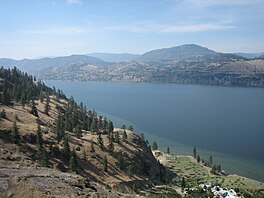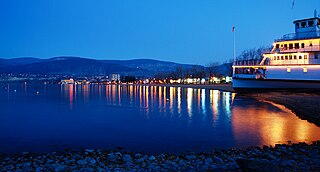
Penticton is a city in the Okanagan Valley of the Southern Interior of British Columbia, Canada, situated between Okanagan and Skaha lakes. In the 2016 Canadian Census, its population was 33,761, while its census agglomeration population was 43,432.

Okanagan Lake is a lake in the Okanagan Valley of British Columbia, Canada. The lake is 135 km (84 mi) long, between 4 and 5 km wide, and has a surface area of 348 km2.

The Okanagan, also called the Okanagan Valley and sometimes the Okanagan Country, is a region in the Canadian province of British Columbia defined by the basin of Okanagan Lake and the Canadian portion of the Okanagan River. It is part of the Okanagan Country, extending into the United States as Okanogan County in north-central Washington. According to the 2016 Canadian census, the region's population is 362,258. The largest populated cities are Kelowna, Penticton, Vernon, and West Kelowna.
Kaleden is an unincorporated community about midway along the western shore of Skaha Lake in the Okanagan region of south central British Columbia. Adjacent to BC Highway 97, the locality is by road about 13 kilometres (8 mi) south of Penticton.

Sicamous is a district municipality in the Shuswap Country region of south central British Columbia. The place is adjacent to the narrows, which is the confluence of Mara Lake into Shuswap Lake. At the BC Highway 97A intersection on BC Highway 1, the locality is by road about 73 kilometres (45 mi) west of Revelstoke, 140 kilometres (87 mi) east of Kamloops, and 75 kilometres (47 mi) north of Vernon.

Seton Lake is a lake in the Squamish-Lillooet region of southwestern British Columbia. On the northeast side is Mission Ridge. On the southwest is the Cayoosh Range. By road, the eastern end is about 7 kilometres (4.3 mi) southwest of Lillooet.

Okanagan Falls is a community located on the south end of Skaha Lake in British Columbia.
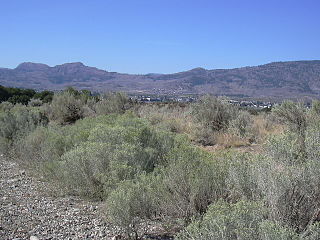
The Okanagan Desert is the common name for a semi-arid shrubland located in the southern region of the Okanagan Valley in British Columbia and Washington. It is centred around the city of Osoyoos and is the only semi-arid shrubland in Canada. Part of this ecosystem is referred to as the Nk'mip Desert by the Osoyoos Indian Band, though it is identical to the shrublands elsewhere in the region. To the northwest of this area lies an arid shrubland near Kamloops.
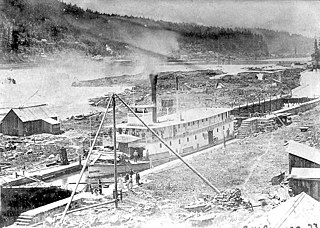
The Willamette River flows northwards down the Willamette Valley until it meets the Columbia River at a point 101 miles from the Pacific Ocean, in the U.S. state of Oregon.

SS Sicamous is a large, four-decked sternwheeler commissioned by the Canadian Pacific Railway (CPR) and was built by the Western Dry Dock and Shipbuilding Company for Okanagan Lake service between the fruit communities of Penticton, and other towns of Kelowna and Vernon, British Columbia. The vessel launched in 1914 and operated until 1937, and it is currently beached as a part of a heritage park cared for by the S.S. Sicamous Marine Heritage Society in Penticton. The vessel today is operated both as a museum, restoration site, and a facility for special events.

Mara Lake is a lake in the Shuswap Country region of south central British Columbia, Canada. To the west is Hyde Mountain and east is Morton Peak. The outlet of the Shuswap River forms the upper reaches. The lower end enters the narrows at Sicamous and flows into Shuswap Lake. The northern end of Mara Lake is by road about 73 kilometres (45 mi) west of Revelstoke, 140 kilometres (87 mi) east of Kamloops, and 75 kilometres (47 mi) north of Vernon.
Okanagan Landing was an unincorporated settlement and steamboat port at the north end of Okanagan Lake in the Southern Interior of British Columbia. Located southwest of the city of Vernon, it was the terminus station for the Shuswap and Okanagan Railway and served as the port and shipyard for steamboats operating to the south, as well as a transfer barge slip.
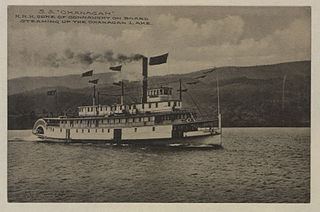
SS Okanagan was a steamship owned and operated by the Canadian Pacific Railway Lake and River Service. The vessel was constructed in 1906 at Okanagan Landing and launched in 1907, becoming Okanagan Lake's second steamship. She linked the transportation hubs at both the north and south ends of Okanagan Lake (Vernon and Penticton, respectively, aiding the development of interior British Columbia with other steamships of the 1900s. The ship was retired in 1934 and sold for scrap and spare parts. Only the Stern Saloon, a room in the back of the upper deck, remains. It was moved to the SS Sicamous Heritage Park in Penticton in 2002, to undergo restoration work.

SS York was a small steamer that was used to haul freight on Okanagan Lake and Skaha Lake. York was built in 1902 by Bertram Iron Works of Toronto and assembled at Okanagan Landing. She was pre-fabricated with a steel hull and was twin-screw-driven. She was a small vessel in comparison to the many other ships on the lake; York was only 88 by 16 feet. York was capable of moving 134 tons in freight and could carry up to 90 passengers.

SS Aberdeen was a steamship commissioned by Canadian Pacific Railway company. It was the first CPR steamship on Okanagan Lake and carried passengers and cargo from Okanagan Landing to Penticton from 1893 to 1919. Aberdeen connected communities along Okanagan Lake for the first time, creating a new era in the Okanagan Valley and greatly aiding the economy and settlement of the interior of British Columbia.
SS Maude-Moore was a wood-burning screw steamer that provided a ferry service between the communities of Summerland, Naramata, and Penticton on Okanagan Lake in British Columbia, Canada.
MV Mallard, later Kaleden, was a ferry that linked the communities of Summerland and Naramata on Okanagan Lake in British Columbia, Canada from 1908 to 1910, and later served Skaha Lake and Kaleden, British Columbia, under the name Kaleden.
SS Fairview was a wood-burning sternwheeler built at Okanagan Landing shipyard in 1894 to run between the communities Penticton and Okanagan Falls, British Columbia, Canada. She was built by M. E. Cousens, chief of engineer of the Canadian Pacific Railway company-owned SS Aberdeen, and was the second steamship built at Okanagan Landing after Aberdeen. Although she was intended to run on Okanagan River between Penticton and Okanagan Falls, then called Dogtown, Fairview was too large for the river and was instead used for passenger and freight service on Okanagan Lake. Fairview caught fire at Okanagan Landing on the return trip from an excursion and burned in 1897.
The Harrop Ferry is a cable ferry at Harrop Narrows on the west arm of Kootenay Lake in the West Kootenay region of southeastern British Columbia. The crossing, off BC Highway 3A, is by road about 27 kilometres (17 mi) northeast of Nelson and 7 kilometres (4 mi) west of Balfour.
